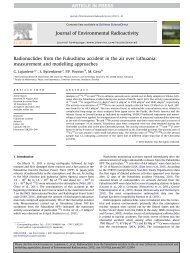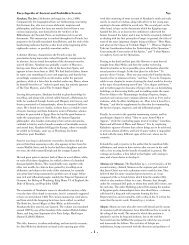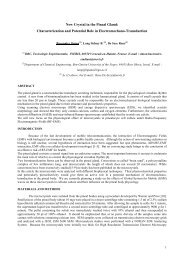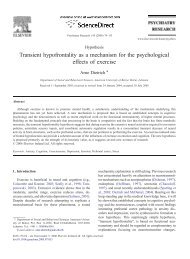splinter <strong>of</strong>f from the main organization. Other terrorist organizations are formed as extremistfactions <strong>of</strong> broader social movements that renounce violence but support the same political goals.These organizational factors are especially useful in explaining how terrorist behavior can becomeself-sustaining regardless <strong>of</strong> objective success or failure and <strong>of</strong> changing conditions.- Wilson argues that the fundamental purpose <strong>of</strong> any political organization is to maintain itself.-Wilson views the position <strong>of</strong> organizational leadership in terms <strong>of</strong> the nature <strong>of</strong> the incentives anorganization provides for its members.- Collins and Guetzkow term these nonpolitical incentives“interpersonal” as opposed to “task-environmental” rewards.- The popular image <strong>of</strong> the terrorist as an individual motivated exclusively by deep and intransigentpolitical commitment obscures a more complex reality. At least four categories <strong>of</strong> motivation can bedefined distinct from the organization’s ideological purpose. These incentives are (1) the opportunityfor action, (2) the need to belong, (3) the desire for social status, and (4) the acquisition <strong>of</strong> materialreward.- There seems to be two patterns <strong>of</strong> group processes relating to the decision to resort to terrorism. Inthe first case, individuals join groups that are on the periphery <strong>of</strong> the actual terrorist organization,which is, in a sense, at the center <strong>of</strong> a concentric circle. People then move through the groups to thecore, sometimes following close friends or relatives. The decision to resort to terrorism is gradualand indirect. Involvement in the terrorist organization may not, at the outset, have been a deliberatechoice.- The second pattern <strong>of</strong> group development occurs when the existence <strong>of</strong> the group precedes thedecision to turn to terrorism. The adoption <strong>of</strong> the terrorist strategy is a collective decision by thegroup as a whole or by a faction within the group. Such decisions are usually hotly debated.- Wilson suggests that the organization’s political purpose affects its stability. He distinguishes threecategories <strong>of</strong> purpose: single-issue, ideological, and redemptive. Although most terroristorganizations are ideological, in the sense <strong>of</strong> being based on beliefs that compromise a systematic,comprehensive rejection <strong>of</strong> the present political world and the promise <strong>of</strong> a future replacement, someare single-issue groups. The Rand Corporation describes issue-oriented groups as common butshort-lived. The third incentive, redemption, is characteristic <strong>of</strong> organizations whose effortsconcentrate primarily on changing the lives <strong>of</strong> their members or followers rather than changing theoutside world.- In their redemptive aspects terrorist organizations resemble religious cults, which generally requirethe absolute commitment <strong>of</strong> members to a rigid system <strong>of</strong> belief that divides the world into the savedand the damned.- Wilson concludes that all conspiratorial organizations tend over time to substitutegroup solidarity for political purpose as the dominant incentive.- The group becomes simultaneously more introverted and unrealistic, as contacts with society aresevered. <strong>Terrorism</strong>, thus, becomes self-sustaining, as the group acts to maintain itself rather than toinstigate political change.- Hirschman maintains that dissatisfied followers <strong>of</strong> an organization have two options: “exit” or“voice.” “Exit” can indicate that two courses <strong>of</strong> action: (1) joining an established rival organizationthat provides more satisfactory incentives; or (2) leaving with enough similarly discontentedassociates to form a new organization.- Exit <strong>of</strong>ten occurs after an attempt to exercise “voice” has failed.- Although terrorist organizationsusually attempt to define exit as betrayal and threaten severe punishment for treason, factionalism isnot uncommon.-Terrorist organizations tend, however, to view “voice” as a more serious threat than exit. Most areextremely intolerant <strong>of</strong> internal dissent, thereby promoting factionalism to resolve internal conflict.- This rigidity has several sources. Cohesion and solidarity are important values- To enforce obedience and acceptance, leaders can rely on only two rational sources <strong>of</strong> authority(they also have a certain command over the group because <strong>of</strong> psychological dependencies). First,their skills at organization and strategy are known by their past record. Second, Verba suggests,generally with regard to small groups, that leaders rely on their position as an “agent <strong>of</strong> impersonalforce” and as representative <strong>of</strong> group norms to legitimize their directives.- Terrorist organizations <strong>of</strong>ten deliberately build loyalty through ideological indoctrination andthrough emphasizing the external threat. Loyalty is demonstrably strongest when the possibility <strong>of</strong>exit exists, but members choose to stay anyway. Organizations establish what Hirschman terms“severe initiation costs” to prevent members’ departures. If members have invested a lot to join an
organization, they will be reluctant to leave.- Given high initiation costs and the corresponding constraints on exit they impose, discontentserious enough to surface is likely to be explosive, and it is not surprising that it <strong>of</strong>ten leads to bitterfactionalism. Paradoxically, extreme discontent may sometimes motivate increased activity toachieve group goals rather than to dissolve the organization.- The behavioral differences between terrorist groups in competitive versus noncompetitivesituations may have significant implications for intensity <strong>of</strong> violence in a terrorist campaign. Undercompetitive conditions, where exit is possible, there should be less internal dissent. On the otherhand, where exit is easy but no competitors exist, small organizations are likely to proliferate.60. Crenshaw, M. (1986). The psychology <strong>of</strong> political terrorism. M. G. Hermann ( Ed), Political psychology:contemporary problems and issues (pp. 379-413). London: Jossey-Bass.Call Number: Key Quote Summary: After 1968 in Western Europe terrorism seemed to replace riotsand protest demonstrations as a dramatic and violet disruption <strong>of</strong> stability, <strong>of</strong>ten disturbing to thepublic because <strong>of</strong> its unexpectedness in societies hitherto thought immune to serious domesticviolence. Ideology has also motivated terrorist resistance to regimes in Latin America and theMiddle East.-In order to generalize about psychological influences on terrorism, one must take into account thediversity and variation <strong>of</strong> the phenomenon.-Answers to the questions <strong>of</strong> why individuals are attracted to terrorism, why terrorism fundssupporters among the population, why a terrorist organization chooses particular strategies, and whyterrorism has extreme effects on some cases but not others depend on political and social context andtype <strong>of</strong> terrorist organization as well as on psychological theory.-Another element in the complexity <strong>of</strong> modern terrorism is its transnational character.-The transnational <strong>of</strong> intention into action is modified by chance and opportunity, neither <strong>of</strong> whichcan be satisfactorily predicted. Furthermore, in asking why terrorism happens, one must distinguishbetween the initiation <strong>of</strong> a campaign <strong>of</strong> terrorism and its continuation in the face <strong>of</strong> governmentreaction. One must also distinguish between why an individual becomes a terrorist and why anorganization (already formed as a group) collectively turns to terrorism. Why terrorists persistdespite the risks involved and the uncertainty <strong>of</strong> reward us an important question. Why terroristorganizations choose the particular strategies they do bombings, kidnappings, or armed attacks, forexample is also significant.-Scholarly analysis should also be attentive to what is meant by becoming a “terrorist” or a member<strong>of</strong> a terrorist organization.-Actually, complex role differentiation exists within terrorist organizations. First, there aresignificant differences between leaders and followers.-As with all forms <strong>of</strong> political behavior, terrorism cannot be studied in isolation from its political andsocial context. The analysis <strong>of</strong> terrorism clearly deals with the intersection <strong>of</strong> psychologicalpredispositions (which may be derived as much from prior experience and socialization as frompsychological traits emerging from early childhood and infancy) and the external environment.-Most analysts agree that there is no common “terrorist personality.” <strong>Terrorism</strong> is not purelyexpressive violence; it is also instrumental.-To argue terrorism does not result from a single personality constellation or from psychopathologyis not to say that the political decision to join a terrorist organization is not influenced or, in somecases, even determined by subconscious or latent psychological motives.-Knutson (1981, p.109) found that the terrorist she interviewed in American prisons were ambivalentin their attitudes toward the use <strong>of</strong> violence.-Some evidence suggests that not all terrorist are ambivalent Morf (1970), in an analysis <strong>of</strong> the earlymembers <strong>of</strong> the Front de Liberation de Quebec (FLQ), found more explicit signs <strong>of</strong> an early interestin violence.-Bollinger (1981), a member <strong>of</strong> the West German study team, also found that some <strong>of</strong> the terroristshe interviewed were attracted to violence which he attributes to unconscious aggressive motives.-Jager (1981, pp.167-169), however, found no common pattern in attitudes toward violence, neitherambivalence nor attraction, among the West German terrorists. Some individuals reported a strongprior aversion to aggression.-Possibly, rather than being attracted to the inherent violence <strong>of</strong> terrorism, some individuals are
- Page 2 and 3: MethodologyWe have defined terroris
- Page 4 and 5: Reference List1. Root causes of ter
- Page 6 and 7: - The experience of discrimination
- Page 8 and 9: justification across all three reli
- Page 10 and 11: 11. Bandura, A. (2003). The origins
- Page 12 and 13: ather then from their own volition.
- Page 14 and 15: -If the women's liberation movement
- Page 16 and 17: technology and science.-Although mo
- Page 18 and 19: effects that help facilitate violen
- Page 20 and 21: academic fields of study.-Terrorism
- Page 22 and 23: one’s own group and towards other
- Page 24 and 25: marked cars, do not mount stationar
- Page 26 and 27: ethnic group: he or she must also s
- Page 28 and 29: third option involves becoming 'thr
- Page 30 and 31: discriminative stimuli that are tem
- Page 32 and 33: him to disengage from the organizat
- Page 34 and 35: or split into terrorist organizatio
- Page 36 and 37: -Part of the complexity of terroris
- Page 38 and 39: focuses on the depressive character
- Page 40 and 41: Call Number: Editor's Annotation: W
- Page 42 and 43: unanimity has only infrequently ser
- Page 44 and 45: sensitivity to betrayal, and securi
- Page 46 and 47: -People may not support a resistanc
- Page 50 and 51: seduced by the lures of omnipotence
- Page 52 and 53: Most past research findings are bas
- Page 54 and 55: terrorist groups break away from la
- Page 56 and 57: -A second general theory of organiz
- Page 58 and 59: -Violence was justified, first of a
- Page 60 and 61: -Conclusion: When disruptive social
- Page 62 and 63: Call Number: Editor's Annotation: C
- Page 64 and 65: terrorist groups even between group
- Page 66 and 67: grievances and his concomitant will
- Page 68 and 69: -Yet forecasting requires theory, t
- Page 70 and 71: highly organized or institutionaliz
- Page 72 and 73: -Underprivileged groups are likely
- Page 74 and 75: situations where the terrorist moti
- Page 76 and 77: 1977), including in the Palestinian
- Page 78 and 79: -Nor can a general theory of civil
- Page 80 and 81: extent to which deprived occupy org
- Page 82 and 83: -The necessary dependence on new-se
- Page 84 and 85: it relates specifically to the regi
- Page 86 and 87: or class of phenomena, within a giv
- Page 88 and 89: progress in the analysis of terrori
- Page 90 and 91: -Loyalty in the face of continuing
- Page 92 and 93: Republican electorate and also with
- Page 94 and 95: ecent 1994-96 cease-fire.- certain
- Page 96 and 97: e reported in news media. Even if a
- Page 98:
eaccompanied back to Italy where he
- Page 101 and 102:
(non believers) facilitates violenc
- Page 103 and 104:
disagreements and disharmony. There
- Page 105 and 106:
autonomy, colonial liberation, raci
- Page 107 and 108:
introduced as the seminal, grass ro
- Page 109 and 110:
identity over personal and familiar
- Page 111 and 112:
-Finally, a comprehensive policy to
- Page 113 and 114:
-It would be naive to think of suic
- Page 115 and 116:
negotiator for the specific situati
- Page 117 and 118:
efused to fight in the Lebanese war
- Page 119 and 120:
-It has been our impression from fr
- Page 121 and 122:
-Many efforts have been made to cat
- Page 123 and 124:
drives that are brought about by (a
- Page 125 and 126:
word.-Consider now the value of ter
- Page 127 and 128:
-The interaction of deprivation and
- Page 129 and 130:
maximize its expected political ret
- Page 131 and 132:
insights into the underlying dynami
- Page 133 and 134:
lengths to secure materials and tec
- Page 135 and 136:
influencing the success of amnesty
- Page 137 and 138:
-The great diversity of terrorism a
- Page 139 and 140:
205. Monroe, K. R., & Kreidie, L. H
- Page 141 and 142:
Call Number: Published Abstract: Di
- Page 143 and 144:
physiological and psychiatric appro
- Page 145 and 146:
2001, suicide attacks amount to 3%
- Page 147 and 148:
numbersas an offering to the bloodt
- Page 149 and 150:
etween radical family involvement a
- Page 151 and 152:
there is no ambivalence concerning
- Page 153 and 154:
dynamics the ‘anarchic-ideologues
- Page 155 and 156:
especially with the parents (33 per
- Page 157 and 158:
esult.-The world is divided into tw
- Page 159 and 160:
pressure from supporters, internal
- Page 161 and 162:
- 1.00 Historical, Cultural, and Co
- Page 163 and 164:
personal rivalry- An extremist fact
- Page 165 and 166:
national governments. At this preli
- Page 167 and 168:
-Normative Orientations directs peo
- Page 169 and 170:
Sicarii views. Insurrection was onl
- Page 171 and 172:
-To have a space of one’s own is
- Page 173 and 174:
outside the normal range of violenc
- Page 175 and 176:
-Various governments sought to curb
- Page 177 and 178:
e older (i.e., 40's-50's)-Sex: Pred
- Page 179 and 180:
liberation Tigers of Tamil Ealam (L
- Page 181 and 182:
electronic communication and inform
- Page 183 and 184:
any other topic on which so much ha
- Page 185 and 186:
has exposed some particular cause b
- Page 187 and 188:
and alone. Ultimately, terrorism re
- Page 189 and 190:
-Conclusions: The motives for param
- Page 191 and 192:
272. Sprinzak, E. (2001). Rational
- Page 193 and 194:
-One way for individuals to handle
- Page 195 and 196:
-Theories of Hate: Fromm (1973/1992
- Page 197 and 198:
student tells the convict his misde
- Page 199 and 200:
literate in EnglishPoor verbal skil
- Page 201 and 202:
features: focusing; personalized vi
- Page 203 and 204:
-Even if idiosyncratic, the process
- Page 205 and 206:
some other agencies’ inaction. We
- Page 207 and 208:
-The RWA is probably the instrument
- Page 209 and 210:
students choose Communist student o
- Page 211 and 212:
state-oriented tradition: by taking
- Page 213 and 214:
phase of semi legality.-Helpers and
- Page 215 and 216:
the neo-Fascists were over 40 years
- Page 217 and 218:
commonality can be found in the utt
- Page 219 and 220:
geographical, and we consider it in
- Page 221:
-The violence struggle against the














